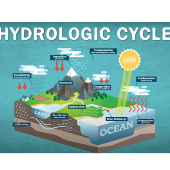CRYOSPHERE
Examples of surface water:
SALTWATER
IMPERMEABLE SURFACES
OGALLALA AQUIFER

CONDENSATION

EVAPOTRANSPIRATION
TRAGEDY OF THE COMMONS
DEADZONE
If the river is fed by runoff that traveled through an agricultural area...
EVAPORATION
Organisms like the beaver...
PRECIPITATION
WATERSHED
FRESHWATER
KEYSTONE SPECIES
DRAINAGE DIVIDE
WETLANDS
RUNOFF
SUSTAINABLE YIELD
PERCOLATION
The highest rate at which a renewable resource can be used forever without reducing its available supply.
It is a continuous moving system of interconnected parts, living and non-living, that are all driven by the Sun.
When a public property that is used by a lot of people is home to a valuable resource and economic interests start competing over it.
Process of water evaporating from holes in plants' leaves and becoming water vapor.
They act as natural speedbumps and filters, slowing the flow of water across the land and cleaning it as it passes through.
It is the largest water deposit in the world.
Like streets, roofs, sidewalks, pavement, etc.... that cause an increase in runoff and can even create massive flooding of polluted water.
When water vapor cools it will then condense to form clouds.
An area of land that drains into a single larger body of water.
Only makes up about 2.5% of the water on the planet.
It makes up 97.5% of the water on the planet.
Water that falls to the surface of the Earth infiltrates down into the soil, becoming groundwater by filling in the spaces between soil and rock.
can dramatically alter an ecosystem and the flow of water.
Their presence not only affects the food web and other organisms that interact with it, but the very structure or survival of the local ecosystem.
It is composed of the total amount of water on a planet, including water that is on the surface of the planet, underground, and in the air (water can be liquid, vapor, or ice).
Water falls back down to the surface of the Earth in a solid or liquid form (as hail, snow or rain).
water can pick up pesticides, herbicides or fertilizers.
Something in the topography or land surface makes water on one side go one way and water on the other side go the other way.
The frozen part of Earth's hydrosphere that is made of ice: glaciers, ice caps and icebergs.
Water that falls to the surface and moves across the land, and with the help of topography and gravity the water will eventually join another body of water.
A zone in the ocean with insufficient oxygen dissolved in the water to support life.
lakes, rivers, wetlands, oceans, ponds or even a puddle.
The heat of the Sun evaporates liquid water, turning it into water vapor.